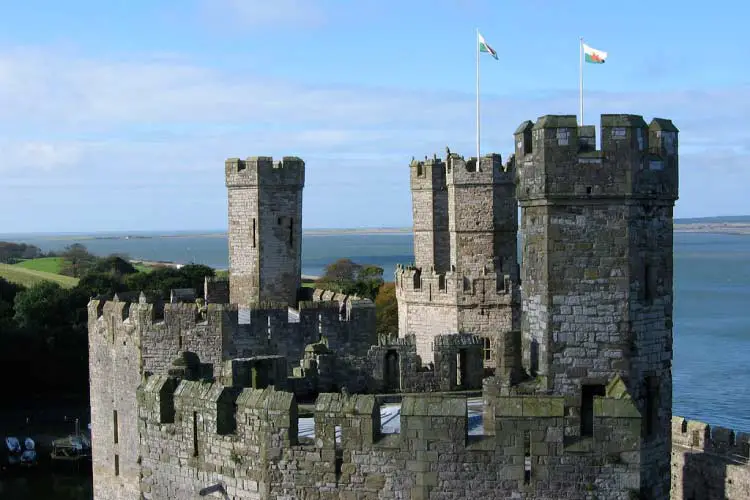Caernarfon Castle
Caernarfon Castle has become one of Wales' most popular tourist attractions and it's one of UK's most awe-inspiring castles. What makes it so extraordinary? The whole small fishing town of Caernarfon sits within the castle's great stone walls. The castle which lies in front of the castle as though to protect it, is quite large, remarkably restored, and a UNESCO World Heritage Site as well. Here's my list of 10 top must-know facts that make Caernarfon Castle so unique and truly worth visiting.
1. It's situated in the royal town of Caernarfon
Caernarfon Castle lies in the town bearing the same name in Gwynedd in the northwest of Wales. It was erected on the right bank and close to the mouth of the River Seiont as a great strategic site.
The town itself is situated on the eastern shore of the Manai Strait, which is some 16 miles long extent of water dividing the island Anglesey from Wales' mainland.
2. A Roman fortress stood near the modern town
A Roman fort called Segontium was erected in 80 A.D. not far from the modern city's walls. The Romans lived in the area and utilized the fortress during their conquest of Britain till they abandoned it in 382 A.D.
The Roman fort's ruins, which remain to this day, can be seen only hundreds of meters to the east of Caernarfon Castle's location.
3. William the Conqueror constructed the original castle
Following the conquest of England by the Normans in 1066, William l set up many castles across Britain. Robert of Rhuddlan was the first Norman to receive control of the area, however, the Welsh killed him in 1088.
A stronger motte-and-bailey type of castle was erected which enjoyed the defense of a wooden keep as well as defensive walls. Later, the motte became part of today's castle, though none of the original building survives.
4. Edward l built the stone castle in 1283
The Norman occupation didn't last long in Gwynedd since the Welsh reconquered the area in 1115, and the castle fell into the Welsh princes' control. But this only lasted as war started with England in 1282, resulting in Edward l capturing the area a year later.
He constructed many castles in Gwynedd to reinforce control and cement his power as their new ruler. The stone castle indeed was one of most stunning castles which were erected at the time.
5. The castle represented a much bigger building program
To state that Edward l was quite serious, that he meant business, would be a huge understatement. He not only constructed a vast stone castle but also thoroughly fortified the small town of Caernarfon by erecting town walls as well as constructed a quay to guarantee the town can be replenished promptly with supplies via the river.
Edward l was not a big believer in wasting time, for the construction went into effect as soon after he took over the area. There's a notation that a ditch got dug to divide the castle and the town on the north side.
6. Both the future English King & Prince of Wales was born here
Caernarfon rapidly grew to be Northern Wales' most important town, which was accentuated by all the men taking turns in protecting the castle 24/7, varying between 20 and 40.
What gave the castle stature was the fact that England's future king, Edward ll, is thought to have been born here in 1284. In addition, he became Prince of Wales in 1301.
The tradition that the monarch's eldest son would become the Prince of Wales still is in effect today.
7. A rebellion left both the castle & Caernarfon in ruins in 1294
8. Edward l invested a lot of money in his castle construction in Wales
The majority of the defenses as well as the town walls were finished in the 1280s. One account claimed it was 1292, but by then, he had already spent $19,558,914 based on today's inflation.
By the year 1330, when the accounts ended, the money invested had nearly doubled and soared above the costliest castle at that time, Dover Castle.
9. The castle was never completed
Although a large sum of money was poured into its construction, it never saw total completion. For example, the rears of the 2 central entrance gates were left unfinished.
10. Its octagonal towers give away its lofty stature
There's little doubt that the castle was intended for greatness from its very beginning: its 12 outstanding, multi-angled towers suggest that it was a castle to rise way above the rest. Moreover, the towers' style is very different to the usual gentler and more rounded feature of the towers common on Edward l's other castles constructed in the same era.

